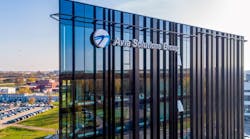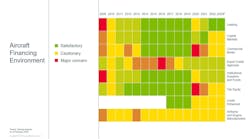Saint Cloud, July 26, 2017 – The Board of Directors chaired today by Mr. Éric Trappier closed the financial statements of the first half of 2017. The statutory auditors performed a limited review of these consolidated financial statements and expressed an unqualified opinion. Éric Trappier, Dassault Aviation’s Chairman and Chief Executive Officer, presented the 1st half 2017 programs’ activities:
FALCON programs
Highlights of the first half of 2017 were:
the delivery of 17 FALCON,
14 FALCON ordered, including a fourth Maritime Surveillance FALCON 2000 ordered by the Japanese coastguard,
extension of the operational capacity of FALCON 8X, a mature aircraft highly appreciated from its entry into service, including:
approval of operations at London City airport,
demonstration of a long-range flight by a Singapore/London flight of 6,300 nm, with a duration of 14 hours,
FAA and EASA certifications of the FALCON Eye system on FALCON 8X,
certification of crosswind takeoff up to 30 knots,
high-speed Satcom certification for the entire FALCON range.
Falcon 5X has made its first flight on July 5th 2017, allowing the wide body twinjet to embark on a limited number of preliminary flight tests.
The 2-hour flight was performed with a preliminary version of the Safran Silvercrest engines, because design issues have delayed the power plant development 4 years beyond the initial schedule (the entry into service of the FALCON 5X was moved from 2017 to 2020).
This advanced flight test campaign will allow to collect data concerning the airframe and systems that could not be generated during a ground test campaign undertaken earlier this spring. The ground campaign included ground runs as well as low and high speed taxi tests.
Flight validation and certification tests will start in 2018, once Safran delivers certifiable engines meeting Dassault Aviation’s specifications.
DEFENSE programs
Highlights of the RAFALE program in the first half of 2017 were:
• the delivery of 1 RAFALE to France, bringing the total number of RAFALE delivered to 149 out of the 180 ordered,
• the delivery of 3 RAFALE to Egypt, bringing to 9 the number of aircraft delivered out of the 24 ordered,
• the delivery of the eighth Naval RAFALE, retrofitted from the F1 to the F3 standard,
• the continuation of development works on the F3-R standard, including the final validation firing of the METEOR missile,
• the continuation of development, production and support work for the RAFALE standards for Egypt, Qatar and India, the continuation of the support of the fleet of RAFALE delivered to France and export customers,
• Indian combat aircraft needs are material (additional batches for its Air Force and 57 aircraft for naval aeronautics), if we are to have any hope of winning these contracts, it is imperative that the “Make in India” is a success.
As such, we created the Dassault Reliance Aerospace Limited Joint Venture (DRAL JV) on February 10, 2017, located in NAGPUR (central India), in which 51% of the capital is held by Reliance and 49% by Dassault Aviation, overseen by a national Indian CEO and an Industrial Director from Dassault Aviation. The corporate purpose of the DRAL JV (civil and military aeronautical activities) is to enable us to meet our offsets commitments in respect with the contract signed to supply 36 RAFALE, to build the foundations to reach our commercial goals with India, and to improve our competitiveness in manufacturing FALCON 2000’s parts in India.
Production will be progressively ramped up over 5 years, from the start of production scheduled for late 2017 to the manufacture of FALCON 2000 components and RAFALE sub-assemblies, in order to build the required infrastructure, to hire and train staff, to ensure procurements, and to check each step.
For Dassault Aviation, this will have a favorable impact on its workload, both for the 36 RAFALE contract and for any future contracts.
• the continuation of promotional and prospecting activities related to the export of RAFALE.
For MIRAGE 2000, it should be noted that in the first half of 2017:
• upgrade work for the French MIRAGE 2000D continued,
• in India, the continuation of the support to Hindustan Aeronautics Ltd. (HAL) in the development of the final standard for the Indian MIRAGE 2000 and in works under its responsibility,
the support of the MIRAGE 2000 fleet to French and foreign forces.
For Maritime Surveillance aircraft, highlights in the first half of 2017 included:
• the continuation of development works to upgrade the combat system on ATLANTIQUE 2, particularly system integration tests and test flights,
• the continuation of development work on FALCON 2000 Maritime Surveillance Aircraft for the Japanese coastguards,
• the start of work on additional capacity for dropping SAR (Search And Rescue) chains for the French Navy’s FALCON 50 SURMAR fleet.
For drones, highlights in the first half of 2017 included:
• the continuation, for France, of the test campaign of the nEUROn in 2017 with radar signature measurements by the French Defense Procurement Agency. We are also negotiating a contract for a new flight campaign in the second half of 2017,
• in the frame of the Franco-British treaty of Lancaster House, the continuation of the feasibility phase and the preparation with our industrial partners BAE Systems, Thales, Leonardo, Rolls-Royce, and Safran of a proposal for a launch, by the end of 2017, of an operational demonstrator Unmanned Combat Air System (UCAS),
• concerning the MALE RPAS (Medium Altitude Long Endurance – Remotely Piloted Aircraft System), the first half of 2017 allowed us to continue the work to define a European program, under the scope of a contract notified in 2016 by the OCCAR (Organization for Joint Armament Cooperation), in conjunction with the French, German, Italian, and Spanish Ministries of Defense. This study brings together Dassault Aviation, Airbus Defence and Space, and Leonardo. At the Franco-German summit on July 13, 2017 an announcement was made on the choice of a twin-engine solution. We are continuing the studies to prepare in 2018 a proposal for a program launch.
After outlining the above activities, Éric Trappier stated:
“The 2017 Paris Air Show provided us with an opportunity to present the RAFALE in flight and the new FALCON 8X, along with other aircraft of our FALCON family at the static display.
It also allowed us to meet:
the new President of the French Republic, the new Prime Minister, the new Defense Minister, as well as other government members. And we took the opportunity to increase their awareness of current and future issues,
FALCON customers and potential customers,
foreign military delegations.
We have to:
insure FALCON sales of all models,
prepare new contracts for RAFALE and successfully implement the essential “Make in India”,
obtain development contracts in France and/or in cooperation (F4, FCAS, MALE, …) to ensure our future by maintaining the skills of our teams,
succeed in the FALCON 5X development program, to respect the 1st deliveries to customers scheduled for 2020, subject to Safran fulfilling its new development schedule commitment,
make sure we are ready to launch a new FALCON program, in order to enlarge our FALCON family,
mobilize all of our resources to successfully achieve our transformation and guarantee the sustainability of the Company. This is precisely the challenge of the “Leading our Future” plan, which will enable us to increase our competitiveness and flexibility.”

